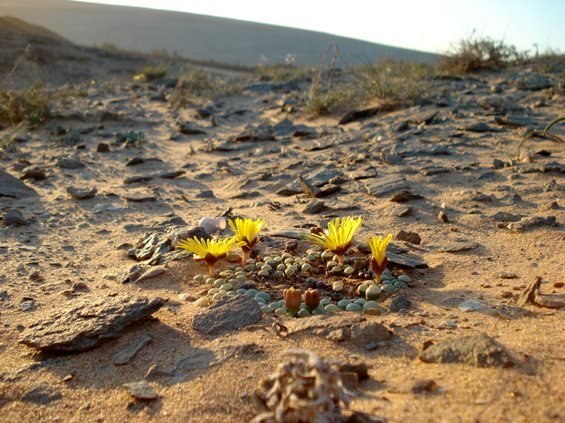Fenestraria rhopalophylla subsp. aurantiaca

Author: Ivan Lätti
Photographer: Judd Kirkel Welwitch
Fenestraria rhopalophylla subsp. aurantiaca grows only in the westerly sandy, mostly flat or comparatively flat region of the Richtersveld. These mesemb plants are found no further than 40 km from the sea.
Bluish leaf tops closer to the camera surround still closed buds, while paler leaves are present under the open flowers further back. The brown sepals of the open flowers have widened and the yellow petals spread angled up. The time of day influences the petal angles, as flowers are only open from noon to late afternoon on sunny days.
High human population density or the trampling accompanying grazing, especially overgrazing by their flocks could easily obliterate these delicate plants. Prospects for plant well-being in the Richtersveld in general are bleak early in the twenty first century due to subsistence farming.
Much of the Richtersveld is by nature desolate. Its plants evolved in times when human activity here was light and minimal; no boots and no vehicle tyres.
The region comprises a rugged, montane, inland part, while the westerly sandy component, the Sandveld, ranges from the sea to the Hardeveld in the Richtersveld heartland in the north and the Namaqualand Klipkoppe to the south.
The Sandveld was still submerged in the sea only 120 000 years ago, in times when there were already primitive people on earth and temperatures were high as they are becoming in our time. Vegetation found here is relatively young in local terms, if not in evolutionary terms, probably mainly spread from the Hardeveld. The species diversity is consequently low, exacerbated by low heterogeneity in topographical features of the land.
Low-growing Asteraceae and Aizoaceae species predominate. What fynbos is present, consists of low volumes of organic matter, therefore not much influenced developmentally by cyclic fires (Grenier, 2019; Frandsen, 2017; Williamson, 2010; Smith, et al, 1998).

